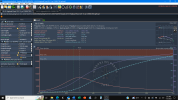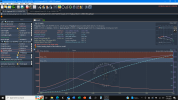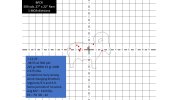So, with a good night's sleep and a dreary day to not make me feel guilty about staying indoors, I revisited GRT and the chrono results from my last few weeks of testing. I realized I was making the common mistake of assuming one parameter was in play when in reality, we know that is hardly ever the case.
I brougnt up the two breech seated loads, one with a 277 gr bullet over 17 gr of 2400 and the other a 225 gr bullet over 15 gr of 2400 and looked at input data that might effect the difference between GRT predicted MV and the chrono readings. Having two different BS examples helped confirm assumptions. My thought was if the assumption applied to one load had the same effect on the other load, then there is a good chance that the assumption is legit. Then I moved to the chrono and GRT data from yesterday's fixed ammo test and tried to see if the same assumptions might apply.
So here is what I'm talking about. I was thinking that BS rounds created a larger effective case volume and this was throwing off the MV prediction. But in reality, since the total case volume is known and I'm seating with zero depth, the total case volume is known and applies. So, there is no error created by breach seating when it comes to effective case volume. So, what else could be affecting the predicted versus actual MV numbers?
GRT has some input cells I will call "correction factors". These are factors that are involved and must be considered. But they are pretty much impossible for a reloader to know or calculate. One is Initial Pressure. This is the pressure when the bullet first starts to move. It is based upon primer energy, friction between the bullet and the case (crimp, neck tension, seating depth) and press-in force into the rifling. Let's compare fixed ammo to breech seated ammo for this parameter.
Fixed Ammo - No crimp, 0.002 neck tension
So when the primer fires, the bullet starts to move in the case. This increases effective volume. The bullet builds inertia and hits the rifling. The inertia helps carry it into the rifling as the pressure continues to build until it reaches its peak chamber pressure.
Breech Seated Ammo - No crimp, no neck tension, already engraved into the rifling
Primer fires and pressure starts to build. Effective case volume is greater since bullet is not taking space in the case. But the bullet is not moving. Pressure builds against the stationary bullet. Since the engraved bullet has to overcome static friction of the rifling the pressure builds higher until the bullet starts to move.
Now, I believe that the pressure required to push the bullet out of the case is less than the pressure required to push the bullet thru the rifling. I tend to believe that the primer has no effect on the BS bullet moving as it does when in fixed ammo. I also suspect that the pressure builds slower in the fixed ammo because the bullet starts to move with the primer, making more space. And since it is moving, there is no static friction to overcome when it hits the rifling. Plus a body in motion tends to stay in motion. So as the powder burns and the pressure builds, the bullet keeps moving and when it hits the rifling that inertia helps it enter and continue down the barrel. So the peak pressure should be lower and occurs at a later point in time.
In the BS bullet, the primer fires and the powder starts to burn and pressure starts to rise. The bullet is stationary and must overcome static friction. Plus a body at rest tends to stay at rest. Hence the bullet stays put. So the pressure builds and builds faster and higher until the bullet starts to move. This tells me that the pressure will build faster and higher as there is no relief until the bullet starts to move.
It was this thought process that made me look hard at initial pressure. One would think that because the BS bullet has created more effective case volume, that initial pressure would be lower than for fixed ammo. But I believe that the static friction of the BS bullet causes the pressure to rise faster and higher, similar to a plugged barrel. So, the analogy I would use is the fixed ammo shoves the bullet and the BS ammo punches the bullet. In order to account for this, I think that the initial pressure for the BS bullet should be higher. GRT asks 3 quetions to determine initial pressure.
- Caliber type- rifle, pistol, or shotgun
- Projectile type - material type soft lead, std to brittle lead, jacketed, solid copper, etc.
- Primer type - standard or magnum.
I used "standard to brittle" for the lead material for BS and "soft lead" for fixed. I did that to account for static friction of the BS bullet in the rifling. And damn if the MV numbers did not suddenly fall in line (or be pretty close) to what I saw over the chronograph. The result was about a 1000 psi difference in initial pressure between the two loads.
Anyone reading this with a good ballistics background or similar, please comment. If I am right, this will help me "accurize" GRT to cast bullet shooting by varying the intial pressure when comparing BS to fixed ammo.
Here are the GRT numbers for each. Note that the BS ammo reached peak pressure faster and his higher than the fixed. Same bullet, same powder charge.





